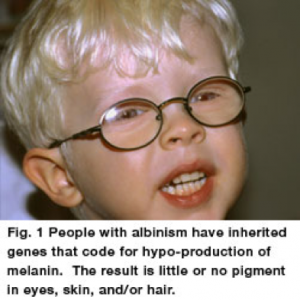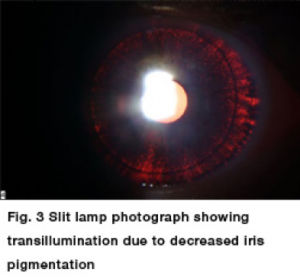What is albinism?

Albinism is an inherited condition present at birth, characterized by a reduced or lack of pigment that normally gives color to the skin, hair, and eyes. [figure 1].
How common is albinism?
One person in 17,000 has some type of albinism. Albinism affects people from all races. Most children with albinism are born to parents who have normal hair and eye color for their ethnic backgrounds. Some patients with albinism have white hair and very light blue eyes, others have blonde hair and blue eyes, and some even have brown hair and eyes. The findings may be subtle and a person may not even know that he or she has albinism.
Are there different types of albinism?
These disorders are generally divided into two types. Oculocutaneous (pronounced Ock-you-low-kew-TAIN-ee-us) Albinism or OCA and Ocular Albinism. OCA involves decreased pigment in the eyes, hair, and skin. There are 4 types of OCA that have been described depending on the type of genetic defect. Ocular albinism involves primarily the eyes, while the skin and hair show normal or near-normal coloration.
What causes albinism?
Albinism is passed from parents to their children through genes. For most types of albinism, both parents must carry an albinism gene to have a child with albinism. Parents may have normal pigmentation but still carry the gene. When both parents carry the gene, and neither parent has albinism, there is a one-in-four chance at each pregnancy that the baby will be born with albinism. This type of inheritance is called autosomal recessive inheritance.
What is X-linked ocular albinism?
In X-linked inheritance, the gene for albinism is located on an X chromosome. Females have two X chromosomes, while males have one X chromosome and one Y chromosome. X-linked ocular albinism appears almost exclusively in males. The gene for it is passed from mothers (who carry it without developing the condition) to their sons. The mothers have subtle eye changes that an ophthalmologist could identify, but they generally have normal vision. For each son born to a mother who carries the gene, there is a 50% chance of having X-linked ocular albinism.
What are the abnormal eye findings of albinism?
- Nystagmus: involuntary eye movements or “shaking”
- Abnormal Head Position: the child develops a preferred head position to reduce the involuntary eye movements (nystagmus) and optimize vision
- Strabismus: misalignment of the eyes.
- Photophobia: sensitivity to bright light and glare
- Refractive Errors: Far-sightedness (hyperopia), near-sightedness (myopia) and astigmatism are very common.
- Foveal hypoplasia: the central part of the retina (the inside part of the eye that perceives light) does not develop normally before birth and during infancy. Without normal development of the central retina, vision is decreased
- Optic nerve misrouting: the nerve signals from the retina to the brain do not follow the usual nerve routes. (figure 2)
- The iris (the colored area in the center of the eye) has little to no pigment to screen out stray light coming into the eye. This is known as iris transillumination. (figure 3)
- Vision can range from normal for those minimally affected, to legal blindness (vision less that 20/200) or worse for those with more severe forms of albinism. Near vision is often better than distance vision. Generally, those who have the least amount of pigment have the poorest vision.
How is Albinism Treated?
Albinism is a lifelong condition that does not worsen with time. Although there is no way to treat poor or absent pigment production or correct abnormal vision development, proper eye evaluation and management can be useful. Eye misalignment can be treated with glasses or surgery. Abnormal head postures and nystagmus can be improved with surgery. Glasses can be prescribed to improve vision and reduce light sensitivity. Magnifying glasses for reading and low vision aids for distance vision can also be helpful.
Genetic counseling of affected individuals and their families is recommended. Counselors can provide a detailed explanation of the disorder including the chances of future children being affected. The American College of Medical Genetics and the National Society of Genetic Counselors maintain a referral list.
What lifestyle adjustments does albinism usually require?
The reduced visual acuity associated with albinism may result in visual difficulties. It may be difficult to see distant objects in the classroom and may require visual aids to maximize visual function. It may also result in the inability to drive and place limitations on vocational choice. Student, parents, and teachers should work as a team to consider seating, lighting, optical aids, and social and emotional growth. Albinism does not typically cause intellectual disabilities and children with albinism usually have normal intelligence.
In addition, individuals with albinism are more susceptible to sunburn and skin cancer, so sunscreen and wide brim hats, as well as sunglasses and/or prescription lens tint are strongly encouraged.
What optical aids are useful in albinism?

The use of optical aids depends on the individual. Some children may do well with ordinary glasses. Some people do well using bifocals which have a strong reading lens. Some may benefit more from contact lenses. Others use hand-held magnifiers or special small telescopes and some prefer to use screen magnification products on computers. For older children and adults, glasses with small telescopes mounted on the lenses may help with both close and distant vision.
What non-medical approaches can help a patient with albinism?
Participation in support groups can help in gathering information, as well as in dealing with feelings about the condition. Children and adults with albinism can benefit from participation in peer support groups. These groups can help the individual to feel less isolated, to learn positive attitudes and coping skills from others with low vision, and to gather valuable resource information.
Are there any other medical conditions associated with albinism?
There are two systemic conditions that are (rarely) present in patients with albinism. Hermansky-Pudlak Syndrome (HPS) is associated with bleeding problems and bruising. Some forms are also associated with lung and bowel disease. HPS is a less common form of albinism but should be suspected if a person with albinism shows unusual bruising or bleeding. Chédiak-Higashi syndrome is a rare disorder that affects multiple systems of the body. The disease is characterized a susceptibility to infections, anemia(low blood count), and hepatomegaly(enlarged liver).
Credits: Journal of American Association for Pediatric Ophthalmology and Strabismus